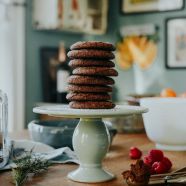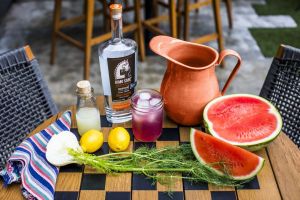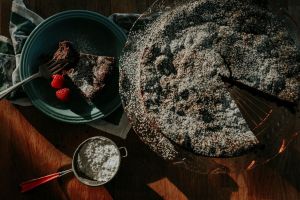Appearance Versus Reality in Food Styling
I once spent over three hours picking through bags of frozen popcorn chicken looking for the most rounded, most “perfect” ones. I have sliced a tall pile of bell peppers, just to get ten slivers that were the “perfect” fish hook shape for a pizza—that pizza, by the way, was never really going to be the focus of the shot in the first place. I have half-filled a pie shell with instant mashed potatoes, piled blueberries over it, topped it with a meticulous lattice pattern, and baked it until golden brown to achieve a “perfect” looking blueberry pie. Food styling is a completely subjective art form and an absolutely bizarre job.
I went to the Culinary Institute of America right out of high school to study pastry and baking and then bolstered my love of food science with my love of body science to become a registered dietitian. After working as a private, corporate chef for a tech company in Austin, Texas, for five years I found that I needed a new challenge . . . making lunch for two hundred people had become old hat. Thankfully, I had entered into a period in my life where I was fully embracing saying yes to everything and seeking opportunities to learn new skills and utilize the ones I had already honed. I come from artist parents who love food and travel, so my whole life has been a platform for using food as my subject and/or medium. I have been baking, cooking, and experimenting since I was in elementary school. My International Baccalaureate art project in high school was food-related sculptures and paintings. When I doodle, I doodle fruit and steaming pots on a stove. I have been playing with food my whole life, and fortunately I crossed paths with food styling, a vocation that caters to the artistic innovator.
A food stylist is the person on a photoshoot, commercial, or film who is in charge of the food. It’s a specialized department under the wing of the art or prop department due to the perishable, finicky nature of the materials. We can be in charge of anything from vague, slightly out-of-focus background food to a close-up “hero” shot of a succulent, juicy, cheese-dripping, steaming, mouthwatering burger. We’re selling the product, whatever the product is. The job requires a person who knows food science, is artistically and aesthetically inclined, and can work with a crew of anywhere from two to two hundred people. The food scientist side needs to understand intuitively how the individual ingredients of the products will react over time during the shoot: sitting at various temperatures in or outdoors until “they” get the lighting or shot blocked, how it will stand up to being repeatedly jostled and moved by an actor (or the director or photographer for that matter), how much something might sweat, weep, or shrivel up, sitting outside of a refrigerator . . . the list goes on. The artistically inclined side must know how something will look, first from an up-close perspective, and then on the monitor, in context (it’s continuously fascinating to me how different something can look on and off camera). And then the food artist must be able to communicate any necessary (or sometimes unnecessary) changes, even if they are the most-minute details most people would never notice.
Which brings me to the side of the food stylist that must work with a crew. Articulation and communication needs to happen with any or all of the following humans: art director, director, assistant director, agency, client, producer, assistants, PAs . . . and it also has to happen in an incredibly short amount of time because “time is money” they say. This is the point in the process that highlights the subjectivity of it all. Whose artistic perception and reality prevails? It’s a continuous ebb and flow.
People have heard behind-the-scenes stories for decades; “Is it true that the milk is not real in cereal commercials? I heard they use Elmer’s glue, right?” “Is all that food fake?” “Do you just use hair spray and paint and resin on everything?” “What’s ice cream made out of?” (Unless we are selling the product, we use a dense mixture of Crisco and powdered sugar for the perfect scoop of ice cream due to the melt factor. There is method to the madness!) The truth is, as with many things in life, we do something a certain way because “that’s the way I was taught,” or “that’s the way my [insert family member] did it,” or “I read it in some book,” that is, until we think for ourselves and innovate. Food styling is a venn diagram of food science, artistic vision, and innovation. The venue for a shoot often poses the first and largest hurdle. Sometimes we cook and assemble on plastic folding tables, under a tent in the middle of a dusty, dry field on a ranch in the Texas Hill Country on a 95 degree day with an extension cord that you cross your fingers will work and coolers that need to keep being refilled with ice. Sometimes you’re on a mobile food trailer that’s parked quite far from the set, has no hot water, and in the winter it’s from this cold, dark hole that you’ll need to produce five different plated dishes that all need to be delivered back to the set all at the same time. Sometimes you have to cobble together a makeshift college-dorm-esk kitchenette on a soundstage, and you are so close to the set that you have to stop literally everything you’re doing every couple of minutes because sound is rolling (and you would be surprised how much noise is made when sauteeing chicken or boiling water). The idiom “necessity is the mother of invention” has never applied more than a food stylist’s impressively wide spectrum of challenges.
Interestingly, being a dietitian-baker is the opposite of a food stylist, in theory. My value system about food politics and physiology leads me to promoting honest, wholesome, healthy, “real” food. Food styling is a reprieve from taking time to develop complex flavors, using the best ingredients, and considering the food’s health benefits. And, I am often free from those annoying food safety constraints. It’s an artistic and scientific challenge in a different way from making an edible meal, and it’s liberating. Often, a food stylist gets to the set and it’s the first time they have ever laid hands on the product. And just as often, something from the storyboard has changed. With my chef-dietitian-baker hat on, the first thing I consider in my order of operation is something about flavor or ingredient combinations. As a food stylist, the first step is anticipating any problems that will stand in the way of manifesting the ideal esthetic of the product to be sold.
The onslaught of Instagram and filters has led to a new realm of what is affectionately referred to as “food porn.” Everyone thinks they are a food stylist or food photographer. Though this could be (and is at times) annoying to a professional, my optimistic side is grateful that people love and appreciate food this much. The constant food posts also bring to light the question of “picture perfect.” Perfection is subjective. Beauty is, proverbially, in the eye of the beholder. I will find the “perfect” popcorn chicken or the unblemished piece of fruit for the client. But, were I the client, I would choose the rustic, “real,” authentic, unmanicured version. Michael Pollan used the phrase “consensus reality” while promoting his book How to Change Your Mind about psychedelics, and it made me smile. Just because a particular populace agrees on a particular “reality,” doesn’t mean it’s the truth. I prefer to question consensus reality. I am inspired and turned on by foraged, imperfect, often frowned-upon, discarded ingredients. My reality is the beauty in the symbiotic nature of the earth and how working for your food, preparing the food, eating in community, and “imperfect” family-style plating is the true beauty. The art is in the story, not necessarily the presentation.
So, while from a fascinated artist’s standpoint I certainly appreciate learning how to literally paint a raw turkey (with caramel-colored Kitchen Bouquet, bitters, and sprinkled dry herbs) to look perfectly cooked because it makes the most sense on an eight-hour shoot for a Christmas-themed tablescape, I will continue to seek beauty and authenticity in the whimsically, perfectly imperfect.










Great insights! I learned a lot. Well done!